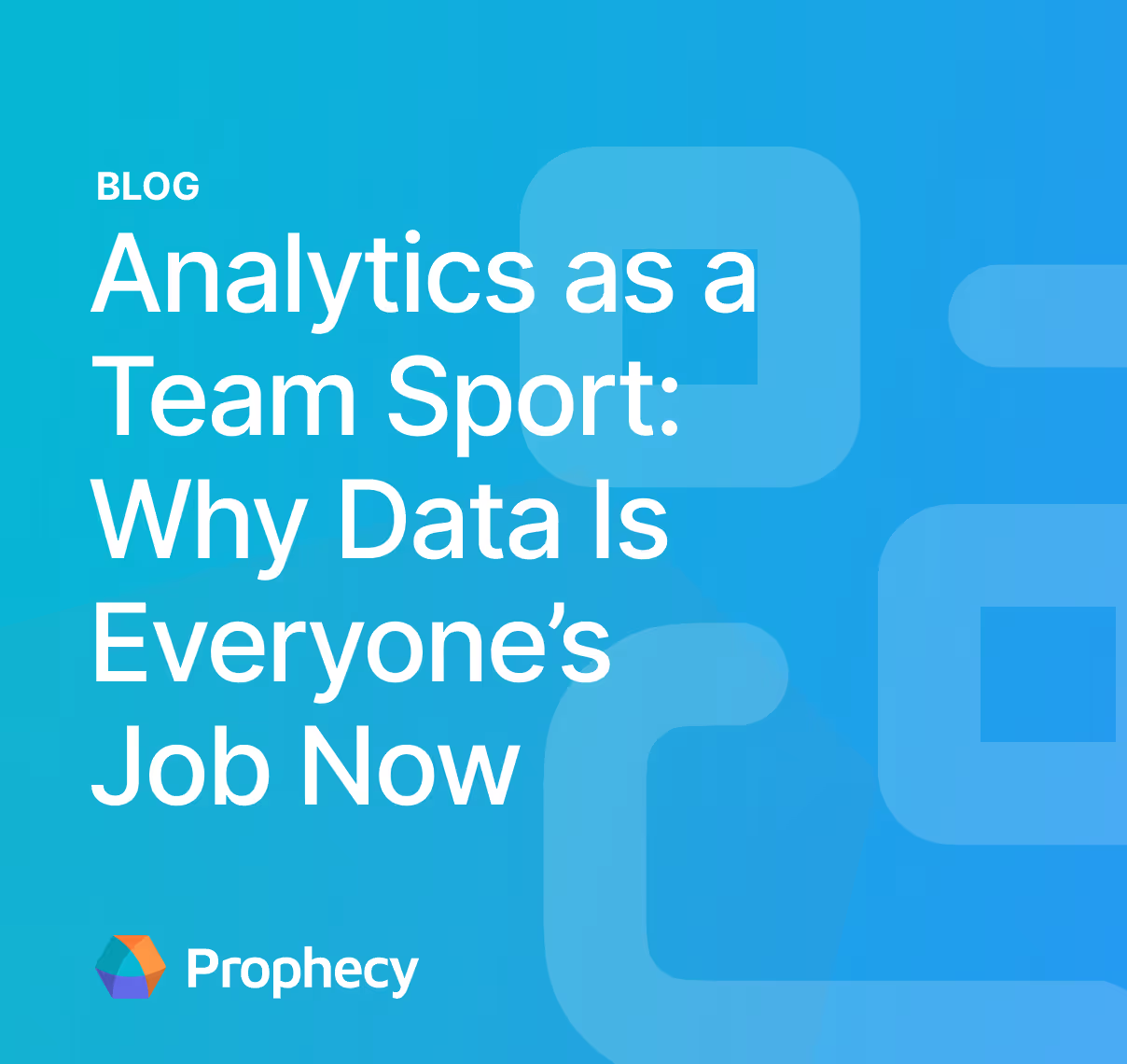The Real Cost of Fragmented Analytics Workflows
Discover how fragmented analytics workflows may be affecting your business and what strategies you can implement to fix it.
If you've ever found yourself waiting weeks for a simple data request, juggling multiple tools just to get basic insights, or watching your team create workarounds because the "official" process takes too long, you're experiencing the hidden tax of fragmented analytics workflows.
Most organizations didn't set out to create a mess of disconnected systems and processes. It happens gradually—a new tool here, a different approach there, each solving an immediate problem without considering the bigger picture. But these seemingly small decisions compound into a significant drag on your organization's ability to make data-driven decisions.
The good news is that fragmented workflows aren't permanent fixtures of your organization. With the right approach and strategic changes, you can transform these disconnected processes into streamlined systems that actually accelerate decision-making instead of hindering it.
Characteristics of fragmented analytics workflows
Fragmented analytics workflows share several telltale characteristics that create friction across your organization:
- Disconnected tools: Your data lives in one system, gets processed in another, visualized in a third, and stored somewhere else entirely. Each tool requires different logins, has different interfaces, and speaks its own data language with little to no integration between them.
- Manual handoffs: Work moves between teams through email attachments, shared drives, or formal request tickets. An analyst exports data from System A, manually reformats it, then uploads it to System B for the next person in the chain to pick up.
- Department-specific processes: Marketing has their own way of pulling customer data, sales uses a completely different approach for the same information, and finance has built their own separate reporting pipeline. Each department has evolved its own methods and tools.
- Multiple approval layers: Getting access to data requires approvals from IT, then the data owner, then your manager, with each step involving different forms, systems, or communication channels. Simple requests bounce between multiple gatekeepers.
- Scattered data sources: Customer information sits in your CRM, transaction data lives in your ERP, web analytics are in another platform, and operational metrics are tracked in various departmental spreadsheets with no unified access point.
- Role-based silos: Data engineers work exclusively in technical environments, business analysts have their own set of tools, executives see only high-level dashboards, and operational staff use completely different systems for their daily work.
- Undocumented processes: Critical analytical workflows exist only in people's heads or scattered across various emails, wikis, and informal notes. When someone leaves or goes on vacation, their colleagues struggle to figure out how reports were generated, where data comes from, or what steps need to be repeated.
How fragmented analytics workflows affect businesses
When your analytics processes are scattered across disconnected systems and teams, the problems compound quickly. What starts as minor inefficiencies in day-to-day operations evolves into significant organizational challenges that impact everything from data quality to competitive positioning.
Poor data quality
Fragmented workflows introduce errors at every handoff point and manual transfer. When data moves through multiple systems and gets reformatted by different people using different methods, inconsistencies and mistakes are inevitable. Fields get mapped incorrectly, calculations vary between processes, and data gets corrupted or lost during transfers. Without standardized processes and automated data validation, your organization ends up making decisions based on unreliable information, eroding trust in your data and analytical outputs.
Security and compliance risks
Every disconnected system and workaround solution creates new vulnerabilities in your data security posture. When teams can't get what they need through official channels, they create shadow solutions by downloading sensitive data to personal devices, using unauthorized cloud tools, or sharing database credentials informally. These practices make it impossible to maintain proper access controls, audit trails, or compliance with regulatory requirements. What starts as a simple efficiency hack can become a serious liability.
Slow delivery
Fragmented workflows turn simple requests into multi-week projects that bounce between multiple teams and systems. Each handoff introduces delays as work sits in queues, gets prioritized differently by each team, and requires coordination across departments with conflicting schedules. While your competitors are making data-driven decisions in real-time, you're still waiting for reports that should have taken hours, not weeks, to generate.
Inconsistent results
When different teams use different tools and processes to analyze the same data, they inevitably produce different results. Marketing's customer acquisition numbers don't match sales' figures, financial reports conflict with operational metrics, and executives receive contradictory information from various departments. These inconsistencies undermine confidence in your data and lead to endless meetings debating which numbers are correct rather than acting on insights.
High costs
Maintaining fragmented workflows requires significant resources across multiple dimensions. You're paying for numerous tools that don't integrate, hiring specialized staff to manage each system, and dedicating countless hours to manual processes that should be automated. Your talented analysts spend their time on repetitive data preparation instead of strategic analysis, while IT teams constantly firefight integration issues and access requests.
Reduced scalability
As your organization grows, fragmented workflows become exponentially more complex and difficult to manage. Adding new data sources, users, or analytical requirements means navigating an increasingly tangled web of systems and processes. What worked for a smaller team becomes unwieldy at scale, and the effort required to maintain these workflows grows faster than the value they provide.
Missed opportunities
Fragmented analytics workflows create blind spots and delays that cause your organization to miss critical business opportunities. While you're struggling to compile data from multiple sources, market conditions shift, customer preferences evolve, and competitive advantages emerge and disappear. By the time you have the insights needed to act, the window of opportunity has often closed, leaving you perpetually reactive instead of proactive in your market approach.
How to fix and avoid fragmented analytics workflows
Transforming fragmented workflows into streamlined processes requires a systematic approach that addresses both technical and organizational challenges:
1. Establish common data standards and definitions
Start by creating organization-wide agreements on how key metrics are defined, calculated, and reported. Business stakeholders from different departments need to align on what terms actually mean. When everyone agrees that "customer acquisition cost" includes specific components and excludes others, you eliminate one major source of conflicting reports.
Document these standards clearly and make them easily accessible to everyone who works with data. Create a central repository where people can quickly look up how metrics should be calculated, what data sources to use, and what quality standards apply. This becomes your single source of truth for analytical consistency.
2. Implement centralized data storage
Consolidate your scattered data sources into a unified storage architecture that provides a single access point for all analytical work. Centralized storage eliminates the need to hunt across multiple systems for data and reduces the manual integration work that creates errors and delays. When your customer data, transaction records, operational metrics, and external data sources all live in the same environment with consistent access patterns, your teams can focus on analysis instead of data wrangling.
Modern cloud data platforms like Databricks, Google BigQuery, and Snowflake offer powerful solutions that combine massive scalability with incredible performance and flexibility. These platforms allow you to store and process all your data in one place while supporting everything from real-time analytics to advanced machine learning workloads.
3. Invest in self-service capabilities with governance
Enable business users to get the data they need without going through lengthy request processes, but do it within a governed framework that maintains quality and security. This means providing tools and platforms that non-technical users can operate while ensuring that data access, transformations, and outputs still meet organizational standards.
The key is balancing empowerment with control. Give people the ability to explore data, create reports, and answer their own questions, but within guardrails that prevent the creation of new inconsistencies or security risks. This reduces the burden on central IT teams while maintaining the oversight needed for compliance and quality.
4. Create reusable components and templates
Instead of having everyone build analytical solutions from scratch, develop a library of reusable components that can be combined and customized for different use cases. This might include standard data transformations, common report templates, validated calculation logic, or pre-built connectors between systems.
These reusable components speed up development, ensure consistency across different analyses, and capture institutional knowledge so it doesn't get lost when people leave. When someone solves a data problem once, make sure that solution can be easily adapted and reused by others facing similar challenges.
5. Implement collaborative development practices
Adopt practices from software development that promote collaboration and knowledge sharing in your analytics work. This includes version control for analytical assets, code review processes for important analyses, and documentation standards that help others understand and build upon existing work.
Encourage cross-functional teams where business users, analysts, and technical staff work together on analytics projects rather than in separate silos. This collaboration helps ensure that technical solutions actually meet business needs while keeping business users informed about technical constraints and possibilities.
6. Measure and monitor workflow efficiency
Track metrics that help you understand how well your analytics workflows are actually working. This includes time from request to delivery, how often the same questions get asked repeatedly, how much effort goes into data preparation versus analysis, and user satisfaction with the analytics process.
Use these metrics to identify bottlenecks and improvement opportunities systematically rather than just responding to the loudest complaints. Regular measurement helps you understand whether changes are actually improving efficiency and where you should focus future optimization efforts.
Streamline your analytics workflows with Prophecy
Prophecy is an AI-native analytics and automation platform purpose-built to unify the way organizations handle analytics, AI, and data transformation. Our platform removes the bottlenecks and inefficiencies that often come with patchwork tools and siloed processes. By providing an intuitive environment that bridges technical and non-technical skill sets, Prophecy empowers teams to work together on modern data platforms without compromising on governance, security, or scalability.
Here’s a deeper look at the features that will help you streamline your analytics workflows:
- Visual pipeline development with dual editing modes: Your business analysts can build data transformations using intuitive drag-and-drop interfaces, while your data engineers can work directly with the generated Spark, Python, or SQL code. Both views stay perfectly synchronized, so technical and non-technical team members can collaborate on the same projects.
- AI-powered guidance and automation: The built-in AI agent helps users at every skill level by suggesting transformations, generating code from natural language descriptions, creating automated tests, and providing explanations for complex logic. This reduces the learning curve for business users while accelerating development for experienced engineers.
- Enterprise governance without gatekeeping: Prophecy integrates with your existing security infrastructure and provides role-based access controls, automated audit trails, and data lineage tracking. This means business teams can access and transform data independently while IT maintains oversight and compliance requirements.
- Reusable components and collaborative workflows: The platform includes Git integration for version control, shared libraries of reusable transformations, and automated documentation generation. When someone builds a useful data pipeline or solves a common transformation challenge, that solution becomes available for others to adapt and reuse.
Even after implementing the right technology, other challenges within your data team may still hold you back from truly efficient analytics workflows. Learn about these and how to fix them in our ebook, Five Dysfunctions of a Data Team.
Ready to give Prophecy a try?
You can create a free account and get full access to all features for 21 days. No credit card needed. Want more of a guided experience? Request a demo and we’ll walk you through how Prophecy can empower your entire data team with low-code ETL today.
Ready to see Prophecy in action?
Request a demo and we’ll walk you through how Prophecy’s AI-powered visual data pipelines and high-quality open source code empowers everyone to speed data transformation
Get started with the Low-code Data Transformation Platform
Meet with us at Gartner Data & Analytics Summit in Orlando March 11-13th. Schedule a live 1:1 demo at booth #600 with our team of low-code experts. Request a demo here.
Related content
A generative AI platform for private enterprise data
Introducing Prophecy Generative AI Platform and Data Copilot
Ready to start a free trial?
Lastest posts

The Future of Data Is Agentic: Key Insights from Our CDO Magazine Webinar

Analytics as a Team Sport: Why Data Is Everyone’s Job Now




